Spider-view: "The Winds of Watoomb"
This arc's villain receives some decent development, providing more engagement than a few underused heroes
—by Nathan on October 23, 2025—
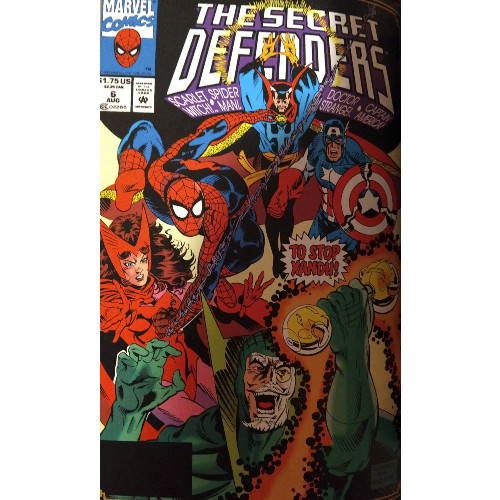
You hear that? Listen closely. It's a wordless whisper, breezing gently by your ear. It's the wind, the wind of memory.
Because if you're like me, the word "Watoomb" stirs a little recollection in your brain, and your comic book gears are turning to remember specifics.
Maybe you remember a man with a monocle, wrapped in a green cloak, who once fought both Spider-Man and Doctor Strange (mainly through mind-controlled lackeys) across dimensions. Maybe you remember that same man trying, on at least two separate occasions, to reconnect with his lost lady love, Melinda, once attempting to rescue her from a death-like sleep by melding her conscience to the Scarlet Witch, and once by breaking free of his own imprisonment in a so-called "Death Dimension" to find her on Earth. At the end of Roy Thomas, Gerry Conway, and Michael Blair's Spider-Man/Dr. Strange: The Way to Dusty Death graphic novel, the roles had been reversed. Xandu was free of the Death Dimension…but Melinda was trapped, physically unable to exist in the same space as her star-struck sorcerer.
But if it's hard keeping a good wizard down, imagine how difficult it is habitually browbeating a bad one…Xandu, like an unwanted house guest, just keeps popping up, always after that darn wand, always after Melinda. And Spidey, with a little help from his buddies, is gonna have to figure out how to end Xandu's nuisance on a more permanent basis.
"The Winds of Watoomb"
Writer: Roy Thomas
Penciler: Andre Coates
Inkers: Don Hudson and Fred Fredericks
Colorist: Jon Kalisz
Letterer: Clem Robins
Issues: The Secret Defenders #6-8
Publication Dates: August 1993-October 1993
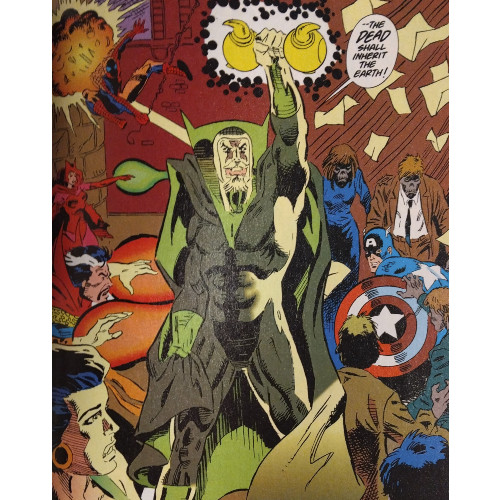
A bit of context before the magic mayhem begins: this is a bit of a different book than I normally review for this series, a mag which does not have "Spider-Man" or any Spidey supporting cast member's name in the title. Were it not for Spidey's appearance and the continuation of the Xandu arc, I probably would have skipped this Secret Defenders series. But we're here, and I intend on reviewing a volume containing the first half or so of the full series in the near future. For now, we're concerned with these issues a short ways into the series, appropriately crafted by Dusty Death writer Roy Thomas.
Thomas had written the adventures of the original Defenders, Marvel's famous "non-team" that was often pulled together, typically by Dr. Strange, for whenever they were needed. Invited to develop this new series in the 90s, Thomas threw in a twist: like before, the Defenders would come together each arc, under Doctor Strange's guidance…but you didn't know who would join the roster. Maybe Wolverine would team up with Nomad and Spider-Woman, or maybe we'd see the unlikely pairing of Namorita and the Punisher. That was the draw of the series. Each team would be a "secret."
Unless a blurb in your series' fifth issue just told you Spidey would appear alongside Scarlet Witch and Captain America…that kinda ruins the whole "secret" part.
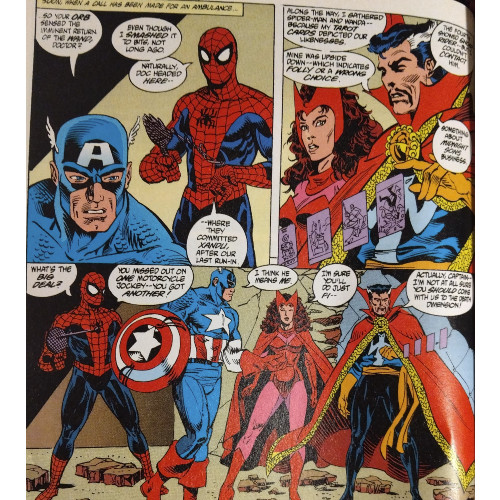
But they are still Defenders! Our motley crew does do quite a bit of defendin' in this three-part tale by Thomas, and though I couldn't call myself much of a fan of the issues preceding this arc, this trilogy has enough entertainment to go around. It's got Spider-Man in it, for one! That's always going to give any story a boost in my estimation.
As I noted in my other reviews covering stories starring Xandu, I would not have anticipated this malicious magic-user receiving as much attention as he did. He was never a mainstay villain, with only 11 appearances to his name, but the fact he received an ongoing plot across most of those appearances is genuinely interesting. He went from power-hungry mad sorcerer to a man deeply in love…or, at least, deeply infatuated. His love for Melinda gives him a genuine motivation, and you can see it as creepy or call him a simp if you want to, absolutely, but that doesn't negate the fact that Xandu, of all characters, is allowed some depth.
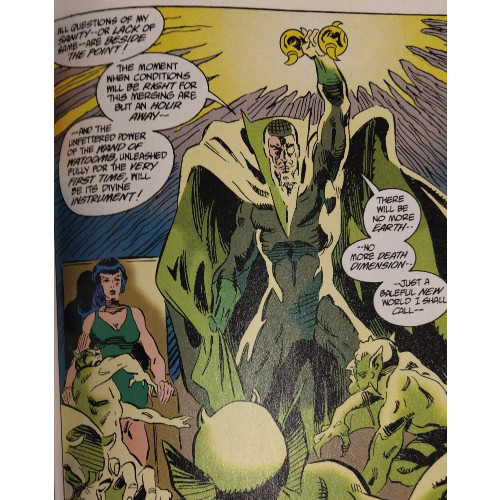
This is a fun continuation of Xandu's story, chronicled periodically since 1965, and by time the madman popped up early in the first issue, I was sold on seeing more of his narrative play out. Our heroes may be the protagonists of this tale, but Xandu remains for me the star. Much like a certain Mad Titan, Xanadu is driven by what he argues is love for another, which, as Thomas indicates, is really love for himself as he seeks to possess what he wants most. And the question does nicely arise: is what he wants most really Melissa? Or is she just a convenient smokescreen to cover his true addiction to power?
I had thought, reaching this point, that his shtick had been done to death already–yes, even with only a handful of appearances, Xanadu's whole "get the Wand of Watoomb and use it to kill Doctor Strange and Spider-Man" had grown a tad stale, despite the additional layers given his character. Thomas recognizes this, I think, and though the magical McGuffin plays a major role in the narrative, the writer does endeavor to separate this tale out from the others. The Wand's power is shown on greater display here, serving not just as a prize to be won but as a force of destruction affecting both Earth and the Death Dimension. The plot feels like a culmination of what has become before, as battles versus Xandu's demonic forces occur in both realities. The raging wizard is at his most volatile and dangerous, spinning all kinds of magical nastiness for our heroes to encounter and confront, leading to an engaging chase scene, a futile early battle, and some later confrontations which keep driving the momentum.
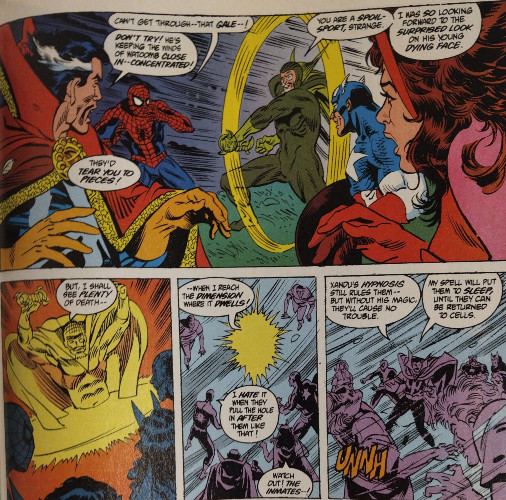
The "team up" aspect both works in Thomas' favor and provides a bit of a hassle. Lemme lay down a positive Tarot card first: Strange, Spidey, and Scarlet Witch are wise choices, all connected by previous encounters with Xandu and aiding this story's nice "sequel" feel. Strange plays the role of enigmatic benefactor, his inclusion necessary yet tinged with possible conflict that causes tension between members of the group; he believes himself at fault for some of the conflict yet where exactly fault lies with him is contested. Spidey allows himself a fine showing, portrayed as a never-say-die go-getter who leaps (literally in some moments) at any chance he can to give his teammates an edge. I enjoyed scenes where the Wall-Crawler stared down the barrel of their blustery adversary, staring magic and horror directly in the face as staunchly as he ever has.
It's the other members, Wanda Maximoff and Steve Rogers, who get the short end of the magic wand in these issues. Wanda finds her spell-casting thwarted by convenient rules at nearly every turn, her prowess showcased in moments yet never enough to defend (no pun intended) her addition to the team other than her history with Xandu. As powerful a character as she should be, Thomas' use of her feels like a slight to her abilities. She was allowed some emphasis in the preceding Marvel Fanfare issue which saw Xandu kidnap her–maybe I was hoping for a slightly bloodthirsty, vengeful Scarlet Witch, charging hard after the wizard. But no. She's largely useless for the length of the narrative.
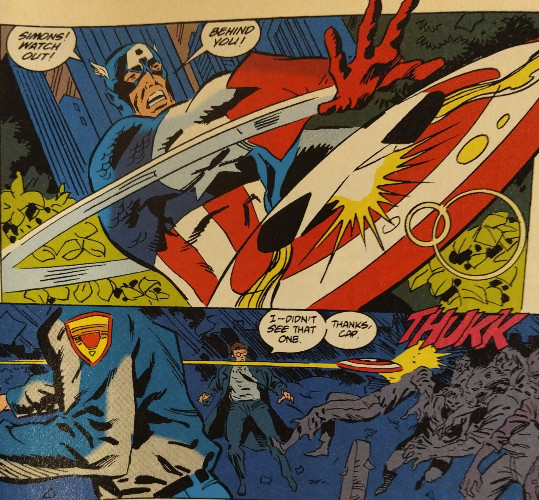
Likewise, Thomas finds a silly, convenient way to temporarily sideline Cap; as the narrative starts to more directly involve Earth, Cap gets in on the action to defend our reality, but until this point, Thomas' reasons for setting him aside are awkwardly enforced,a issue I took with at least one other Secret Defenders arc (though more on that during the actual Secret Defenders review). Important as he becomes in the latter half of the story, Cap's inclusion could be more complete, and even if Thomas just needed someone to remain on Earth, he creates a fairly silly method of "benching" the First Avenger. Also, Thomas pulls out the strangest metaphor I've heard in a long time by comparing Rogers to a "star-spangled duck"...? Bit of a fowl use of figurative language there, Thomas.
Andre Coates provides pencils for this trilogy, and though I am unfamiliar with his work, I found his style engaging enough for most of the narrative. A scene where he draws skeletal husks of our main heroes is wonderfully grim, particularly a Spider-Man mask which seems to follow the contours of his cheek bones. The third issue, surprisingly, features a dip in quality. I'm not sure if the change in inker between issues caused this or if Coates felt rushed, but the detail I found I appreciated in the first two issues just isn't present. Scenes feel more sloppily handled, especially figures, which do not stand out as well as they did in the remainder of the narrative.
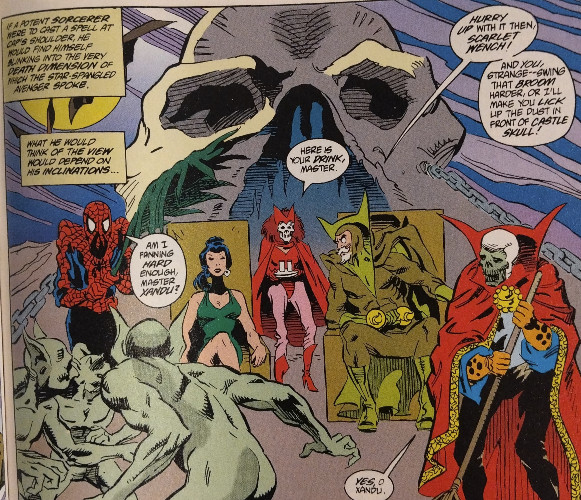
There's some strangeness to this story, then, and I mean beyond the spell-slinging doctor. If you look at this as Xandu's story, you get a fairly entertaining tale. He's the clear villain of the piece, yet he plays the haphazard hero, the misunderstood love of Melinda. If you only listened to him, empathized with him, understood how he felt…y'know, typical conceited villain stuff. He's the hero of his own narrative, naturally, and Thomas wields his pompousness well. It's some other characters, a few of the actual heroes, where Thomas fumbles his spell-casting. His Doctor Strange? A little morally torn. His Spider-Man? Stalwart in the face of great evil. Yet his Cap and Scarlet Witch are not nearly as effective as they could be, their voices lost in the whirling winds of Watoomb which threaten to wrack two realities. Thomas, it seems, plays a little spell on our heroes, making them pliable to his needs and contrivances, which somewhat warp an otherwise entertaining narrative.